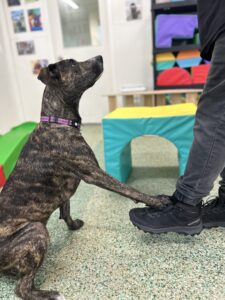 The start of a new year is the perfect time to hit the refresh button—not just for yourself but for your dog too! Whether you’ve been meaning to work on basic manners, address behavioral challenges, or teach some fun new tricks, 2025 can be the year you and your furry friend thrive together. Establishing training goals is a great way to strengthen your bond, keep your dog mentally and physically stimulated, and set the foundation for a lifetime of good habits.
The start of a new year is the perfect time to hit the refresh button—not just for yourself but for your dog too! Whether you’ve been meaning to work on basic manners, address behavioral challenges, or teach some fun new tricks, 2025 can be the year you and your furry friend thrive together. Establishing training goals is a great way to strengthen your bond, keep your dog mentally and physically stimulated, and set the foundation for a lifetime of good habits.
Here’s how to set achievable training goals for the year and make 2025 a success for you and your pup!
Why Set Training Goals for Your Dog?
Just like us, dogs benefit from learning new skills and reinforcing old ones. Training isn’t just about teaching commands; it’s about building trust, confidence, and communication. Setting training goals can:
- Address any lingering behavioral issues.
- Prevent boredom by introducing mental challenges.
- Create a stronger bond between you and your dog.
- Ensure your dog is well-behaved and adaptable in various environments.
Steps to Set Training Goals
- Evaluate Your Dog’s Current Skills
Take stock of what your dog already knows and where there’s room for improvement. Ask yourself:
- Does my dog respond reliably to basic commands like “sit,” “stay,” and “come”?
- Are there any undesirable behaviors, like jumping on guests or pulling on the leash, that I’d like to address?
- Are there fun tricks or advanced skills I’ve always wanted to teach my dog?
This assessment will help you pinpoint areas to focus on.
- Set Specific and Achievable Goals
Break down your training goals into clear, manageable steps. For example:
- Instead of saying, “I want my dog to be better behaved,” try, “I want my dog to walk politely on a leash within three months.”
- If you’d like to teach a trick, like “roll over,” break it into small actions and work on them consistently.
Be realistic about your dog’s age, breed, and temperament. Puppies may need basic training, while older dogs may benefit from mental stimulation or refresher training.
- Create a Training Schedule
Consistency is key when it comes to training. Dedicate short, daily sessions (10-15 minutes) to work on your dog’s goals. For example:
- Morning: Practice recall (“come”) in the backyard.
- Afternoon: Work on leash manners during a walk.
- Evening: Teach a new trick or play a mentally stimulating game.
Stick to a routine that fits your lifestyle, and remember to be patient—progress takes time!
Training Goals to Consider for 2025
- Strengthen Basic Commands
If your dog already knows basic commands, work on improving their reliability in different environments. Practice commands like “sit,” “stay,” “down,” and “leave it” with distractions, such as in a busy park or around other pets.
- Improve Recall (Coming When Called)
A strong recall is one of the most important skills for any dog. Make it a goal to ensure your dog comes back to you reliably, even when there are tempting distractions like other dogs, people, or wildlife.
- Master Leash Manners
If your dog tends to pull or zigzag during walks, focus on loose-leash walking. This will make walks more enjoyable for both of you and ensure your dog is safe around traffic and other hazards.
- Address Problem Behaviors
Does your dog jump on visitors, bark excessively, or chew on furniture? Dedicate time to addressing these issues by identifying the root cause (e.g., boredom, anxiety) and using positive reinforcement techniques to redirect their behavior.
- Introduce New Tricks
Teaching tricks is a fun way to keep your dog mentally stimulated. Start with simple ones like “shake” or “spin,” and work your way up to advanced tricks like “roll over” or “play dead.”
- Socialization and Confidence Building
If your dog is shy or reactive, make 2025 the year to focus on building their confidence. Gradually expose them to new people, places, and situations, always keeping the experience positive and stress-free.
- Try a New Activity
Expand your dog’s skills by trying something new, like agility training, nose work, or obedience competitions. These activities challenge your dog physically and mentally while strengthening your bond.
Tips for Success
- Use Positive Reinforcement
Reward your dog with treats, praise, and affection for good behavior. Dogs are more motivated to learn when training is fun and rewarding.
- Be Consistent
Consistency is crucial for reinforcing good behavior. Ensure all family members are on the same page when it comes to training methods and rules.
- Celebrate Small Wins
Progress may be slow at times, but every step forward is worth celebrating. Stay patient and acknowledge your dog’s efforts, no matter how small.
- Seek Professional Help if Needed
If you’re struggling with a particular behavior or need guidance, don’t hesitate to consult a professional dog trainer or attend a group class.
 Make 2025 Your Dog’s Best Year Yet!
Make 2025 Your Dog’s Best Year Yet!
Training is an ongoing journey, and the new year is an opportunity to strengthen your relationship with your dog while teaching them valuable skills. By setting clear goals, staying consistent, and making the process enjoyable, you’ll not only see progress but also create lasting memories with your furry friend.
Here’s to a year full of growth, learning, and tail-wagging fun! 🐾